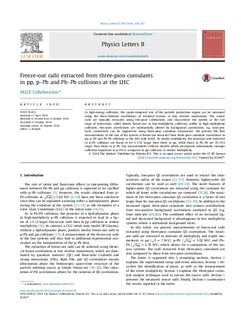Freeze-out radii extracted from three-pion cumulants in pp, p-Pb and Pb-Pb collisions at the LHC
Journal article, Peer reviewed
Permanent lenke
http://hdl.handle.net/11250/2374026Utgivelsesdato
2014Metadata
Vis full innførselSamlinger
- Institutt for mikrosystemer [546]
- Publikasjoner fra CRIStin [3623]
Originalversjon
10.1016/j.physletb.2014.10.034Sammendrag
In high-energy collisions, the spatio-temporal size of the particle production region can be measured using the Bose–Einstein correlations of identical bosons at low relative momentum. The source radii are typically extracted using two-pion correlations, and characterize the system at the last stage of interaction, called kinetic freeze-out. In low-multiplicity collisions, unlike in high-multiplicity collisions, two-pion correlations are substantially altered by background correlations, e.g. mini-jets. Such correlations can be suppressed using three-pion cumulant correlations. We present the first measurements of the size of the system at freeze-out extracted from three-pion cumulant correlations in pp, p–Pb and Pb–Pb collisions at the LHC with ALICE. At similar multiplicity, the invariant radii extracted in p–Pb collisions are found to be 5–15% larger than those in pp, while those in Pb–Pb are 35–55% larger than those in p–Pb. Our measurements disfavor models which incorporate substantially stronger collective expansion in p–Pb as compared to pp collisions at similar multiplicity.
